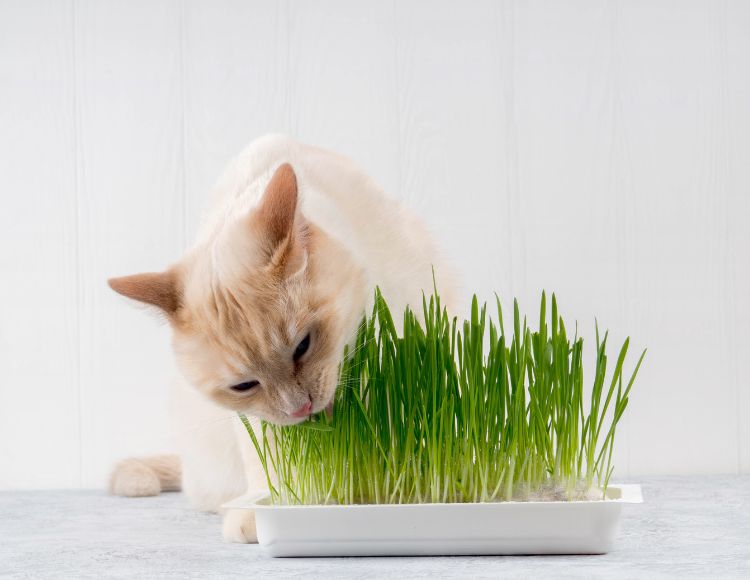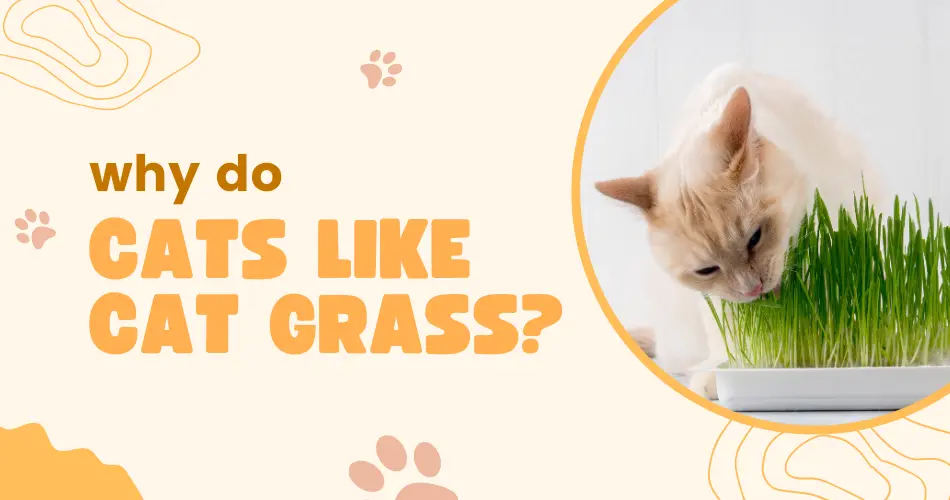If you have a cat and are interested in gardening, you might have noticed that cats enjoy exploring plants and sometimes even eating them. One such plant that cats love to nibble on is cat grass. But what exactly is cat grass, and why do cats find it so appealing?
Cats are often drawn to cat grass due to its nutritional benefits and the digestive aid it provides. This natural feline attraction can be traced back to their wild ancestors and is crucial to their overall health and well-being.
In this article, we will know why cats enjoy eating cat grass.
What Is Cat Grass?

Cat grass is a type of edible grass that comes from cereal grains such as wheat, oats, and barley. It is different from catnip or catmint. These belong to the mint family and elicit a behavioral response in cats. On the other hand, cats are attracted to cat grass because of its physical health benefits.
Cat grass is a great source of folic acid and fiber. This helps in digestion and prevents hairball formation. For indoor cats, cat grass is a necessary substitute for the grass they would typically consume outdoors. This ensures they receive the necessary roughage to maintain a healthy digestive system. Planting cat grass can safely provide your indoor cats with beneficial greens.
The Reasons Why Cat Like Cat Grass
The exact reasons cats are drawn to cat grass are not scientifically proven. Rather, several theories suggest it could be due to instinctual behavior, digestive aid, nutritional needs, gastrointestinal relief, intestinal health, and stress relief.
1. Instinctual Behavior
Cats have inherited their instinctual behavior to consume grass from their wild ancestors. This helps the animals purge their digestive systems of indigestible materials, such as fur or bones, by inducing vomiting.
Although domestic cats’ diets have changed, eating grass remains a natural reflex. This behavior can trigger a cleansing process that assists in removing hairballs and other non-digestible content.
2. Digestive Aid
Grass is like a natural medicine for cats. It helps them digest their food better. Cat grass also works by making their intestines move more easily. This also helps things like hairballs pass through the gut more smoothly. This is because grass has fibers that help push things along.
Cats eating grass can help prevent blockages and promote gastrointestinal health by naturally expelling substances that cause discomfort. This helps to keep cats healthy and avoid more serious issues.
3. Nutritional Need
Cat grass is a great source of essential nutrients, such as folic acid, which is extremely important for a cat’s overall health. Folic acid, a type of vitamin B, helps produce and maintain new cells and is crucial for the transportation of oxygen in the bloodstream.
Moreover, cat grass aids in metabolism and converts carbohydrates into energy. These also contribute to a healthy immune system. Cat grass can be an important supplement to a cat’s diet by providing these essential nutrients, particularly for those who are kept indoors and have limited access to varied natural nutrients.
4. Gastrointestinal Relief
Eating grass may provide cats with gastrointestinal relief. It is a form of self-medication. When cats experience stomach discomfort or soreness, possibly from indigestion or hairballs, they may instinctively turn to grass.
Cats have a natural remedy for their health and comfort. They induce vomiting by ingesting grass, which is counterintuitive. However, this action helps expel irritants from their stomachs. This will remove the associated pain or nausea.
5. Intestinal Health
Cat grass fiber promotes feline intestinal health by aiding regular bowel movements and preventing constipation and associated complications. Moreover, cat grass helps a cat’s digestive system stay healthy, which improves overall well-being. It’s a simple and useful addition to a cat’s diet.
6. Stress Relief
Cats can feel more relaxed and less stressed by eating grass. This behavior is believed to have a calming effect that helps to reduce their anxiety levels.
Cats find joy in simple, repetitive actions such as nibbling on grass. It allows them to focus solely on the activity, which can be a meditative process and a break from environmental stressors. This natural behavior can significantly contribute to a cat’s emotional well-being and contentment.
The Difference Between Cat Grass and Regular Grass
Cat grass and regular grass are different. Cat grass is a cereal grain like wheat, barley, or oats that cats can eat. It is grown indoors specifically for cats to consume. Outdoor regular grass can harm cats because it can be any species, including those that are unsafe for cats to eat.
Then, cat grass is grown without harmful chemicals like pesticides or herbicides, making it safe for your feline friend to consume. Regular grass may contain these chemicals, which can risk your cat’s health—choosing cat grass over regular grass is best to ensure your cat’s safety.
Plus, cat grass is rich in nutrients like folic acid and fiber. This is beneficial for a cat’s digestion and health. On the other hand, regular grass may not provide the same nutritional value.
Cat grass is intentionally kept short and tender. It is ideal for a cat’s delicate digestive system. On the other hand, regular grass can be tough to digest for the cats.
Moreover, cat grass is safer for indoor cats than regular grass. It is cleaner and easier to control, which helps ensure that cats do not come into contact with pollutants and parasites.
Is Cat Grass Safe for Cats?
Cats can safely and healthily eat cat grass. This type of grass provides folic acid, aids digestion, and helps with hairball expulsion. In addition, it can be a satisfying part of their diet.
However, it’s crucial to monitor your cat’s consumption. Excessive eating may indicate health issues. Always consult a veterinarian if you’re concerned. Additionally, ensure cat grass is grown separately from other houseplants, some of which may be toxic to cats.
Maintaining a dedicated cat grass area can provide a safe and healthy option for your feline friend’s grazing habits.
Conclusion
Cat grass offers a safe and nutritious option for our feline companions. This provides essential nutrients and aids in their digestive health. While not all aspects of its appeal are scientifically proven, the benefits of cat grass are clear.
It’s a simple addition to a cat’s environment that can enhance their well-being and satisfy their instincts. It also offers a safe outlet for their grazing behavior. Always ensure it’s grown safely, and consult a vet if overconsumption occurs.

